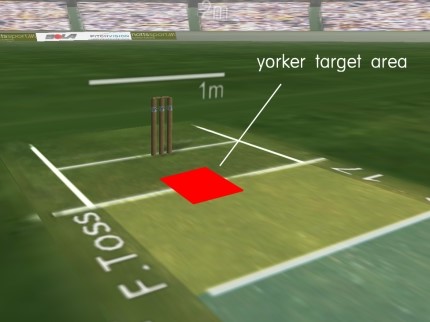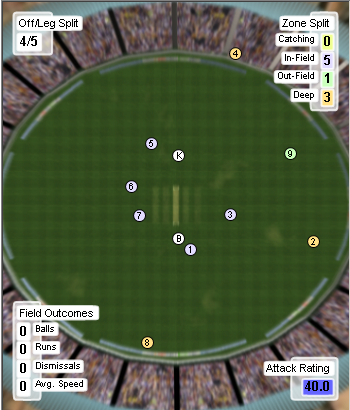|
 Bowling the last few overs of an innings is like being a Hollywood star. When everything goes well you are adored. Put one foot wrong and your embarrassment could not be more exposed. Bowling the last few overs of an innings is like being a Hollywood star. When everything goes well you are adored. Put one foot wrong and your embarrassment could not be more exposed.
For the starlets it's wearing the wrong dress at a premier, for you it's getting clouted for 20 in the final over of the match. Same difference. So how do you avoid the cricketing equivalent of appearing on Perez Hilton?
Master the four balls of death
The secret to good death bowling comes in two parts:
- Be able to bowl the four death deliveries better than anyone else
- Know which of the four balls is the one to use
Both skills are tough. Learning to bowl a ball at will takes a lot of practice at creating a repeatable action. Knowing when to use it takes experience.
Let's take a look at each of the four balls and how best to use them.
1. Slower ball
The slower ball's job is to upset the rhythm of the batsman. It can be bowled in a number of ways (and to get the technique for them you should pick up copy of The Fast Bowler's Bible) but the trick is to do it without changing action.
This means the batsman is fooled into thinking the ball is arriving at normal speed and mis-times his shot.
Bowl it just short of a length to keep the pretence up, but avoid bowling it on a length he can play forward to as this gives him greater margin for error.
The danger with this ball is that the batsman spots it early and it just becomes a slow, shorter ball he can pull into the stands. Avoid this by making sure it's well disguised and use it sparingly, even at the death.
2. Length ball
We are taught that the best ball in cricket is the one that is hitting the top of off stump after pitching on a length that has the batsman undecided whether to play forward or back.
At the death this is risky, because the batsman is no longer playing 'properly' and is looking to hit the ball in unorthodox ways. The good length ball is easier to hit with premeditated shots over extra cover or midwicket.
However, it's still a good ball to have available in certain situations:
- If there is still some movement in the air or off the pitch.
- If the batsman is struggling to put bat on ball.
- If the batsman is premeditating to hit everything to leg, bowling it wide outside off stump.
Don't be too quick to write off the good length ball at the death, it has a use if you are clever.
3. Bouncer
If you bowl a good pace on decent wickets, you can use the shorter ball to restrict the batsman's scoring area and with a well set field you will keep the runs down. There are two ways to use the short ball:
- Stock ball. Batters who don't play the ball at the ribs well will struggle to score against the ball bowled accurately at chest height. If the pitch is hard and bouncy enough you can set your length so the ball reaches chest height with the yorker or slower ball as variation.
- Shock ball. For those batsmen who are better at hooking and pulling (or are sitting on the back foot), the bouncer becomes a variation: Something to stop the batsman premeditating a front foot shot. It's especially good against the player who prefers to go off side in the death as the bouncer forces them to think twice about playing inside-out (i.e. stepping to the leg side to hit the ball through the covers).
With both these tactics, it's important to set a good field. Variations are many, but a deep midwicket, deep square leg and fine leg cut off the boundaries and take catches. Third man is up assuming there are field restrictions:

4. Yorker
The yorker, as we know, is a fast ball pitching at the toes of the batsman, usually around the popping crease, ideally with swing. This is the classic ball for death bowling: Full and straight.
The mantra is: If you miss, I hit.
It's hard to bowl as the margin for error is small. Bowl it too full and it becomes a low full toss and a free hit. Bowl it too short and it becomes a half volley and you will be fetching it from the crowd.
If you can get it right it becomes an excellent stock ball to use at the death. Unless the batsman is very good it can only be hit straight down the ground, so you can set your mid on, mid off, fine leg and third man back and straight to cut off the boundaries.
If you are using it as a stock ball you will need to practice it in the nets a lot both with and without batsmen. It's worth the effort if you know you are likely to be bowling at the end and might suffer 5 overs of the long handle.
It can also be used as a variation if you are using length or short bowling as the stock delivery.
Either way, the mark of a really good death bowler is one who can use the yorker to restrict scoring and take wickets because it is so difficult to master.
With all death bowling the key is not to be average at all four types of bowling, but to become really good at one or two. If you can master all four deliveries you will be unstoppable.
Discuss this article with other subscribers
|

.jpg)




.jpg)


